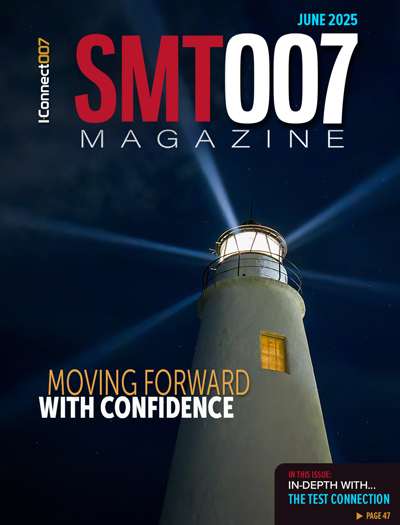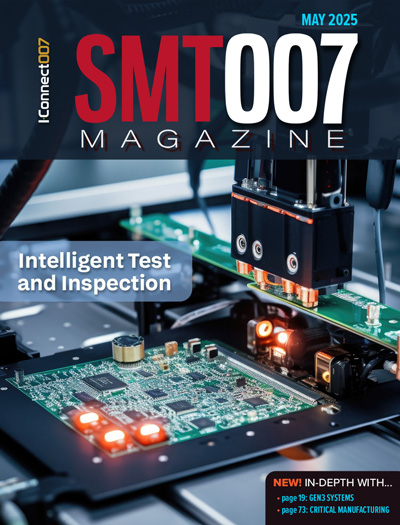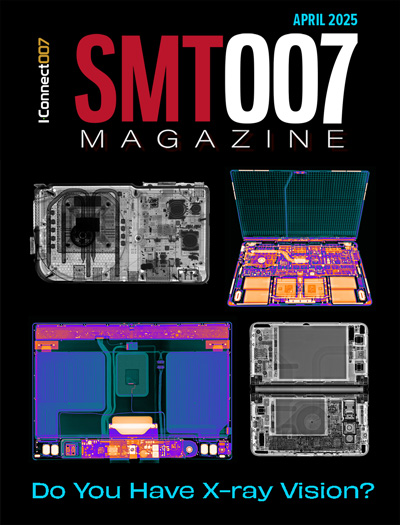-

-
News
News Highlights
- Books
Featured Books
- smt007 Magazine
Latest Issues
Current Issue
Moving Forward With Confidence
In this issue, we focus on sales and quoting, workforce training, new IPC leadership in the U.S. and Canada, the effects of tariffs, CFX standards, and much more—all designed to provide perspective as you move through the cloud bank of today's shifting economic market.

Intelligent Test and Inspection
Are you ready to explore the cutting-edge advancements shaping the electronics manufacturing industry? The May 2025 issue of SMT007 Magazine is packed with insights, innovations, and expert perspectives that you won’t want to miss.

Do You Have X-ray Vision?
Has X-ray’s time finally come in electronics manufacturing? Join us in this issue of SMT007 Magazine, where we answer this question and others to bring more efficiency to your bottom line.
- Articles
- Columns
- Links
- Media kit
||| MENU - smt007 Magazine
Is Component Testing Using ROSE Practical?
September 6, 2018 | Joe Russeau, Precision Analytical Laboratory, and Mark Northrup, IEC ElectronicsEstimated reading time: 3 minutes
In a previous article, "It's Time to Retire ROSE Testing," we discussed the basis for why ROSE testing should be retired as an industry cleanliness or process control test. In this article, we reemphasize our position by highlighting some work we presented at the 2017 SMTA International Conference comparing component cleanliness results from the Resistivity of Solvent Extract (ROSE) against Ion Chromatography (IC) results. For those of you interested in reviewing that body of work, the working title was "PCBA Component Cleanliness Specifications Limits are Lacking."
The ROSE test has been used in the electronics industry since the early 1970s. It was originally developed to estimate the amount of residual rosin flux remaining on a printed board. The predominant flux from that era contained greater than 30% rosin. So, it should go without saying that modern day flux technology and circuit designs are vastly different from those 70s-era predecessors. By that same token, our methods for assessing the ionic cleanliness of printed board assemblies are vastly different as well, right? Well, not exactly. The ROSE test is still the most predominantly used ionic cleanliness test in our industry and in truth, it has not been modified or changed since the early 1980s. In addition, ROSE testing is not only used for determining the ionic cleanliness of printed boards and printed board assemblies, but it is also being used for evaluating the cleanliness of components.
In the previous article, Mark and I indicated that there were two important attributes necessary for evaluating the ionic cleanliness of PCBs and PCBAs. These attributes would be considerably more crucial for evaluating components. We said that those two attributes were selectivity and sensitivity. To properly evaluate ionic cleanliness, it is important to use as little extraction solvent as possible (to concentrate the residues to the area being evaluated) and to have a system that can identify each specific residue that is present. The ROSE test provides a single bulk value (not ion selective) and liters of solution are often used, which affects the sensitivity. Please consider the results in the following table taken from our 2017 SMTAi presentation.
Figure 1: IC has considerably greater selectivity than does ROSE and can identify specific ion species from a sample extract.
Before I discuss the results in Figure 1, it would be prudent to first discuss what was done. First, the cleanliness of five different ball grid array (BGA) groups (i.e., size, ball count and pitch) was baselined using IC. We processed two replicates for each group because we had a limited number of parts to work with. The BGAs were then sent to be re-balled using a standard robotic reballing process. The ionic cleanliness of each group was then re-evaluated using the ROSE test as defined in the GEIA-STD-0006 and again with IC. The solvent volumes used for each test were 5ml for the IC test and 98ml for the ROSE test.
The different ions listed in Figure 1 are from the IC test. As we have indicated, IC has considerably greater selectivity than does ROSE and can identify specific ion species from a sample extract. At the bottom of the table is a red circle around the ROSE and IC results. The ROSE result is expressed as μg of NaCl equivalents per square centimeter. It is important to understand that this is neither a measurement of sodium nor chloride, but an expression of the result compared to a standardized solution of a NaCl salt, which is used to standardize the instrument. The IC results are given as micrograms of ion per square centimeter. The IC results are direct measurements made back to certified standards of specific ion species. Each ion species is calibrated separately.
To read the full article, which appeared in the August 2018 issue of SMT007 Magazine, click here.
Suggested Items
Magnalytix and Foresite to Host Technical Webinar on SIR Testing and Functional Reliability
06/26/2025 | MAGNALYTIXMagnalytix, in collaboration with Foresite Inc., is pleased to announce an upcoming one-hour Webinar Workshop titled “Comparing SIR IPC B-52 to Umpire 41 Functional & SIR Test Method.” This session will be held on July 24, 2025, and is open to professionals in electronics manufacturing, reliability engineering, and process development seeking insights into new testing standards for climatic reliability.
Defense Speak Interpreted: Is DARPA Still Around After CHIPS?
06/24/2025 | Dennis Fritz -- Column: Defense Speak InterpretedWhen I first published my Defense Speaks Interpreted column in January 2019 on the Defense Advanced Research Projects Agency (DARPA ERI), the agency advocated for an expanded Defense emphasis on closing the growing technology gap in microelectronics. The emphasis was on “resurgence.”
I-Connect007 Editor’s Choice: Five Must-Reads for the Week
06/13/2025 | Marcy LaRont, I-Connect007Today is Friday the 13th, and in much of Western folklore, this is a day when bad luck is lurking. But while Friday the 13th may top Western superstition charts, the global calendar is sprinkled with its own unlucky legends. In Spain and Greece, the bad juju lands on Tuesday the 13th—a day linked to Mars, the god of war, and naturally, chaos. In Italy, it’s Friday the 17th that is feared, thanks to the Roman numeral XVII, which can be rearranged to spell VIXI—Latin for “I have lived” (a poetic way of saying you’re dead).
TTCI Celebrates Melanie Rutkauskas’ 10-Year Anniversary and Her Leadership of New Training Division
06/12/2025 | TTCIThe Test Connection Inc. (TTCI), a leading provider of electronic test and manufacturing solutions, is proud to celebrate Melanie Rutkauskas on her 10-year anniversary with the company.
Bridging the Knowledge Gap in Test: A Conversation with Bert Horner
06/11/2025 | Barry Matties, I-Connect007Bert Horner is a seasoned industry veteran and co-creator of The Test Connection, Inc. (TTCI), a test and inspection company spanning over 45 years. In this candid conversation, Bert reflects on the challenges our industry faces with the retirement of career professionals and the subsequent loss of critical tribal knowledge. As he unveils The Training Connection’s innovative training initiatives, Bert emphasizes the importance of evolving educational programs that align with industry needs, particularly in design for test (DFT), and sheds light on strategies being implemented to foster the next generation of engineers.


